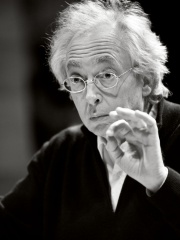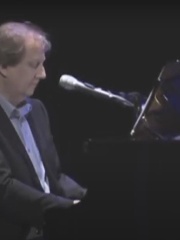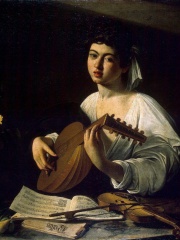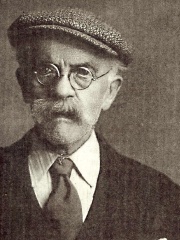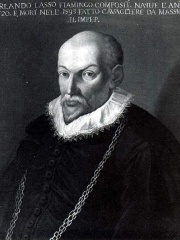
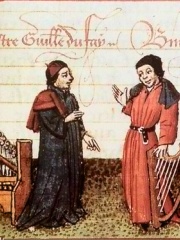
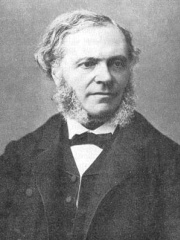
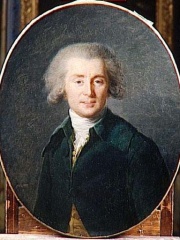
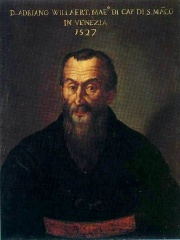
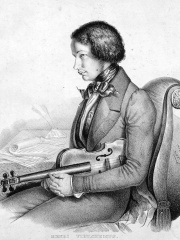
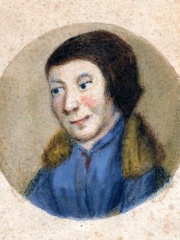
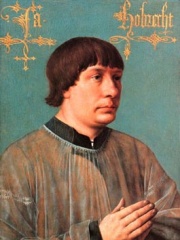
The Most Famous
COMPOSERS from Belgium
Top 10
The following people are considered by Pantheon to be the top 10 most legendary Belgian Composers of all time. This list of famous Belgian Composers is sorted by HPI (Historical Popularity Index), a metric that aggregates information on a biography's online popularity. Visit the rankings page to view the entire list of Belgian Composers.

1. Orlande de Lassus (1534 - 1594)
With an HPI of 79.92, Orlande de Lassus is the most famous Belgian Composer. His biography has been translated into 54 different languages on wikipedia.
Orlando di Lasso (various other names; probably c. 1532 – 14 June 1594) was a composer of the late Renaissance. The chief representative of the mature polyphonic style in the Franco-Flemish school, Lasso stands with William Byrd, Giovanni Pierluigi da Palestrina, and Tomás Luis de Victoria as one of the leading composers of the later Renaissance. Immensely prolific, his music varies considerably in style and genres, which gave him unprecedented popularity throughout Europe.

2. Guillaume Du Fay (1397 - 1474)
With an HPI of 79.12, Guillaume Du Fay is the 2nd most famous Belgian Composer. His biography has been translated into 54 different languages.
Guillaume Du Fay ( dyoo-FEYE, French: [ɡijom dy fa(j)i]; also Dufay, Du Fayt; 5 August 1397 – 27 November 1474) was a composer and music theorist of early Renaissance music, who is variously described as French or Franco-Flemish. Considered the leading European composer of his time, his music was widely performed and reproduced. Du Fay was well-associated with composers of the Burgundian School, particularly his colleague Gilles Binchois, but was never a regular member of the Burgundian chapel himself. While he is among the best-documented composers of his time, Du Fay's birth and family is shrouded with uncertainty, though he was probably the illegitimate child of a priest. He was educated at Cambrai Cathedral, where his teachers included Nicolas Grenon and Richard Loqueville, among others. For the next decade, Du Fay worked throughout Europe: as a subdeacon in Cambrai, under Carlo I Malatesta in Rimini, for the House of Malatesta in Pesaro, and under Louis Aleman in Bologna, where he was ordained priest. As his fame began to spread, he settled in Rome in 1428 as musician of the prestigious papal choir, first under Pope Martin V and then Pope Eugene IV, where he wrote the motets Balsamus et munda cera, Ecclesie militantis and Supremum est mortalibus. Amid Rome's financial and political disorder in the 1430s, Du Fay took a leave of absence from the choir to serve Amadeus VIII, Duke of Savoy. Du Fay returned to Italy in 1436, writing his most admired work, the complex motet Nuper Rosarum Flores, which celebrated the consecration of Filippo Brunelleschi's dome for the Florence Cathedral. He later joined the recently moved papal court in Bologna, and was associated with the House of Este in Ferrara. For the next eleven years, Du Fay was in Cambrai serving Philip the Good, under whom he may have written now-lost works on music theory. After a brief return to both Savoy and Italy, Du Fay settled in Cambrai in 1458, where his focus shifted from song and motet, to composing English-inspired cyclic masses based on cantus firmus, such as the Missa Ave regina celorum, the Missa Ecce ancilla Domini, the Missa L'Homme armé and the Missa Se la face ay pale. During his final years in Cambrai, Du Fay wrote his now-lost requiem and both met and influenced the leading musicians of his time, including Antoine Busnois, Loyset Compère, Johannes Tinctoris and particularly, Johannes Ockeghem. Du Fay has been described as leading the first generation of European musicians who were primarily considered 'composers' by occupation. His erratic career took him throughout Western Europe, forming a 'cosmopolitan style' and an extensive oeuvre which included representatives of virtually every polyphonic genre of his time. Like Binchois, Du Fay was deeply influenced by the contenance angloise style of John Dunstaple, and synthesized it with a wide variety of other styles, including that of the famous Missa Caput, and the techniques of his younger contemporaries, Ockeghem and Busnois.

3. César Franck (1822 - 1890)
With an HPI of 76.63, César Franck is the 3rd most famous Belgian Composer. His biography has been translated into 52 different languages.
César Auguste Jean Guillaume Hubert Franck (French: [sezaʁ oɡyst ʒɑ̃ ɡijom ybɛʁ fʁɑ̃k]; 10 December 1822 – 8 November 1890) was a French Romantic composer, pianist, organist, and music teacher born in present-day Belgium. He was born in Liège (which at the time of his birth was part of the United Kingdom of the Netherlands). He gave his first concerts there in 1834 and studied privately in Paris from 1835, where his teachers included Anton Reicha. After a brief return to Belgium, and a disastrous reception of an early oratorio Ruth, he moved to Paris, where he married and embarked on a career as teacher and organist. He gained a reputation as a formidable musical improviser, and travelled widely within France to demonstrate new instruments built by Aristide Cavaillé-Coll. In 1859, he became titular organist at the church Sainte-Clotilde, a position he retained for the rest of his life. He became professor at the Paris Conservatoire in 1872; he took French nationality, a requirement of the appointment. After acquiring the professorship, Franck wrote several pieces that have entered the standard classical repertoire, including symphonic, chamber, and keyboard works for pipe organ and piano. As a teacher and composer he had a vast following of composers and other musicians. His pupils included Ernest Chausson, Vincent d'Indy, Henri Duparc, Guillaume Lekeu, Albert Renaud, Charles Tournemire and Louis Vierne. His best known works include Symphony in D minor, the Violin Sonata and a setting of the Panis angelicus.

4. André Grétry (1741 - 1813)
With an HPI of 72.23, André Grétry is the 4th most famous Belgian Composer. His biography has been translated into 37 different languages.
André Ernest Modeste Grétry (French: [gʁɛtʁi]; baptised 11 February 1741; died 24 September 1813) was a composer from the Prince-Bishopric of Liège (present-day Belgium), who worked from 1767 onwards in France and took French nationality. He is most famous for his opéras comiques. His music influenced Mozart and Beethoven both of whom wrote variations on his works.
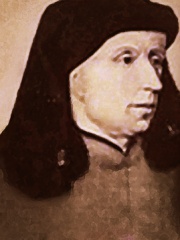
5. Johannes Ockeghem (1410 - 1497)
With an HPI of 72.22, Johannes Ockeghem is the 5th most famous Belgian Composer. His biography has been translated into 42 different languages.
Johannes Ockeghem (c. 1410 – 6 February 1497) was a Franco-Flemish composer and singer of early Renaissance music. Ockeghem was a significant European composer in the period between Guillaume Du Fay and Josquin des Prez, and he was—with his colleague Antoine Busnois—a prominent European composer in the second half of the 15th century. He was an important proponent of the early Franco-Flemish School. Ockeghem was well associated with other prominent composers of the time, and spent most of his career serving the French royal court under Charles VII, Louis XI and Charles VIII. Numerous poets and musicians lamented his death, including Erasmus, Guillaume Crétin, Jean Molinet and Josquin, who composed the well-known Nymphes des bois for him. It is thought that Ockeghem's extant works represent only a small part of his entire oeuvre, including around 14 masses, 20 chansons and fewer than 10 motets—though the exact numbers vary due to attribution uncertainties. His better-known works include the canon-based Missa prolationum; the Missa cuiusvis toni, which can be sung in any mode; the chanson Fors seulement; and the earliest surviving polyphonic Requiem.

6. Adrian Willaert (1490 - 1562)
With an HPI of 71.12, Adrian Willaert is the 6th most famous Belgian Composer. His biography has been translated into 35 different languages.
Adrian Willaert (c. 1490 – 7 December 1562) was a Flemish composer of High Renaissance music. Mainly active in Italy, he was the founder of the Venetian School. He was one of the most representative members of the generation of northern composers who moved to Italy and transplanted the polyphonic Franco-Flemish style there.

7. Henri Vieuxtemps (1820 - 1881)
With an HPI of 70.77, Henri Vieuxtemps is the 7th most famous Belgian Composer. His biography has been translated into 35 different languages.
Henri François Joseph Vieuxtemps (French: [ɑ̃ʁi fʁɑ̃swa ʒozɛf vjøtɑ̃]; 17 February 1820 – 6 June 1881) was a Belgian composer and violinist. He occupies an important place in the history of the violin as a prominent exponent of the Franco-Belgian violin school during the mid-19th century. He is also known for playing what is now known as the Vieuxtemps Guarneri del Gesù, a violin of superior workmanship.

8. Gilles Binchois (1400 - 1460)
With an HPI of 69.60, Gilles Binchois is the 8th most famous Belgian Composer. His biography has been translated into 36 different languages.
Gilles de Bins dit Binchois (also Binchoys; c. 1400 – 20 September 1460) was a Franco-Flemish composer and singer of early Renaissance music. A central figure of the Burgundian School, Binchois is renowned a melodist and miniaturist; he generally avoided large scale works, and is most admired for his shorter secular chansons. Contemporary musicologists generally rank his importance below his colleague Guillaume Du Fay and the English composer John Dunstaple, but together the three were the most celebrated composers of the early European Renaissance. Binchois was born in Mons (modern-day Belgium) to an upper-class family from Binche. His youth is largely unknown, although early chorister training is likely; by late 1419 he had obtained a local organist post. By 1423 he was in Lille and probably a soldier under the Englishman William de la Pole, eventually in Paris and Hainaut. Sometime during the 1420s, Binchois settled in the culturally thriving court of Burgundy under Philip the Good, where he became a subdeacon and was awarded numerous prebends. He retired to Soignies in 1453 amid a substantial courtly pension, dying in 1460. It is thought that considerably more of his sacred music survives than secular music, creating a "paradoxical image" of the composer. Reflecting on his style, the Encyclopædia Britannica comments that "Binchois cultivated the gently subtle rhythm, the suavely graceful melody, and the smooth treatment of dissonance of his English contemporaries".

9. Jacob Obrecht (1457 - 1505)
With an HPI of 69.45, Jacob Obrecht is the 9th most famous Belgian Composer. His biography has been translated into 31 different languages.
Jacob Obrecht (also Hobrecht; 1457/8 – late July 1505) was a Flemish composer of masses, motets and songs. He was the most famous composer of masses in Europe of the late 15th century and was only eclipsed after his death by Josquin des Prez.
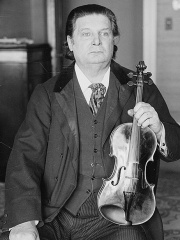
10. Eugène Ysaÿe (1858 - 1931)
With an HPI of 69.23, Eugène Ysaÿe is the 10th most famous Belgian Composer. His biography has been translated into 38 different languages.
Eugène-Auguste Ysaÿe (French: [øʒɛn iza.i]; 16 July 1858 – 12 May 1931) was a Belgian virtuoso violinist, composer, and conductor. He was regarded as "The King of the Violin", or, as Nathan Milstein put it, the "tsar".
People
Pantheon has 31 people classified as Belgian composers born between 840 and 1953. Of these 31, 2 (6.45%) of them are still alive today. The most famous living Belgian composers include Philippe Herreweghe, and Wim Mertens. The most famous deceased Belgian composers include Orlande de Lassus, Guillaume Du Fay, and César Franck.
Living Belgian Composers
Go to all RankingsDeceased Belgian Composers
Go to all RankingsOrlande de Lassus
1534 - 1594
HPI: 79.92
Guillaume Du Fay
1397 - 1474
HPI: 79.12
César Franck
1822 - 1890
HPI: 76.63
André Grétry
1741 - 1813
HPI: 72.23
Johannes Ockeghem
1410 - 1497
HPI: 72.22
Adrian Willaert
1490 - 1562
HPI: 71.12
Henri Vieuxtemps
1820 - 1881
HPI: 70.77
Gilles Binchois
1400 - 1460
HPI: 69.60
Jacob Obrecht
1457 - 1505
HPI: 69.45
Eugène Ysaÿe
1858 - 1931
HPI: 69.23
Jacques Arcadelt
1507 - 1568
HPI: 68.72
Pierre De Geyter
1848 - 1932
HPI: 67.28
Overlapping Lives
Which Composers were alive at the same time? This visualization shows the lifespans of the 13 most globally memorable Composers since 1700.

